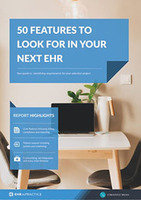4 Medical Billing Workflows Your EHR Should Support
Your practice staff members work hard day in and day out, from those in the front office to the coders, billers, nurses, and doctors. EHR transitions come with a cost, but that cost can often be outweighed by returns. After all, providers want payment.
The billing office’s job is to bring in money by following up with insurance companies. Believe it or not, you can help your billing staff by ensuring that your EHR supports the following medical billing workflows.
1. Automated coding to catch duplicates and reduce denials
Maybe your office struggled with training. Maybe you needed to bring in extra coders for a while, especially if you practiced dual-coding. However, your pain could be at an end (if you have automated coding). Automated coding pulls information from EHR, sometimes through keywords but usually through the actual data input at the time of service.
Remember those paper superbills? They are now electronic. With the click of a mouse, you can start a process (it usually runs overnight) that codes brand-new claims based on the information within the EHR. In many cases, it can catch duplicates before they go out the door, limiting the number of denials your office receives. Of course, more complicated coding, such as surgical coding, requires some additional attention to ensure your medical billing workflows reduce workload rather than increasing it.
GET EHR RESEARCH & KNOWLEDGE RIGHT TO YOUR INBOX
Covering the key issues faced by businesses selecting and implementing EHR.
2. Real-time data access for medical billing
Although this is not necessarily an automated process, it will become an automatic process. The more providers, nurses, and other staff members input data into a patient’s record, the more complete the information available to the billing office.
If I am on the phone with the insurance company and they want to know why a denied claim should be sent back for processing, it is far easier for me to draw from the real-time information available in the EHR than it is to go back to the provider or nurse and ask why something was or wasn’t done.
Guide: 50 features to look for in your next EHR
A biller can see the whole picture, and he or she has the ability to print all relevant information to send with an appeal. A biller’s access to real-time data enables them to prompt insurance companies to pay claims quickly.
3. Electronic submission, verification, & rejection
An essential EHR medical billing workflow is automatic electronic submission. After claims go through automated coding and are released (i.e., not flagged for additional review), claims fly out the door to insurance carriers.
On top of automatic submission, a good EHR verifies whether the carrier received and accepted the claim for processing. An even better EHR verifies the assigned claim number for you (which is important if a carrier asserts that no claim was received).
Seven key features to look for in an EHR billing module
Additionally, an automated process can let you know if a carrier rejects a claim and why it was rejected. Add a place for rejected claims to filter into, and you have a great place from which billers can work—fixing problems before claims hit to ensure timely filing.
4. Payment tracking
The fourth essential medical billing workflow follows on from the first three; payment tracking. Gone are the days of spreadsheets and paper ledgers. A good EHR allows offices to track the payments they receive.
Additionally, payments automatically hit each patient’s account, zeroing out claims and posting denials. The process can keep track of your money and denial trends, allowing billers to identify commonly denied CPTs or combinations of CPTs. Early identification can lead to…you guessed it…more money.
Free white paper

50 features to look for in your next EHR
A comprehensive guide to EHR features and how they can benefit your practice

Featured white papers
Related articles
-

Top requirements for medical billing
Key features to consider when selecting an EHR for medical billing
-

Medical billing software: how it takes the strain off your finance team
Three areas where medical billing software can make life easier for your finances team
-

How to compare EHR medical billing modules
With the majority of EHR systems now supporting medical billing, what points of comparison can be...




